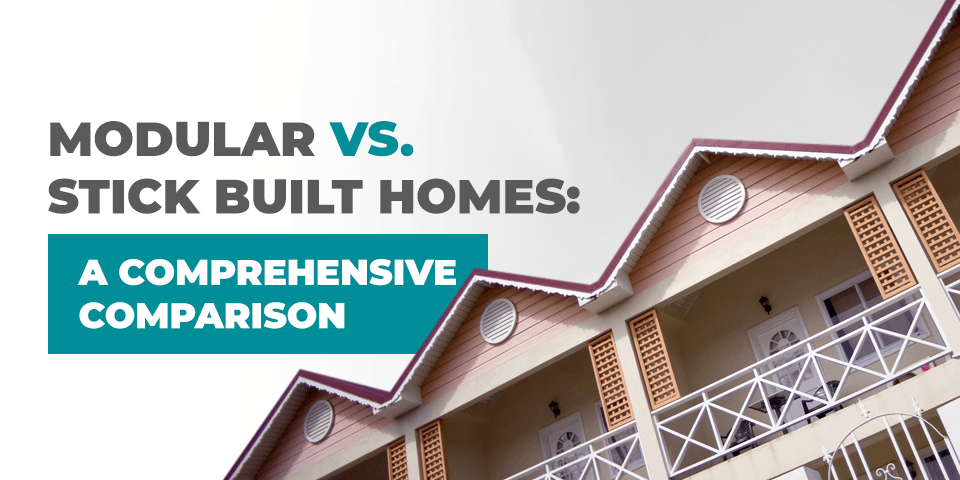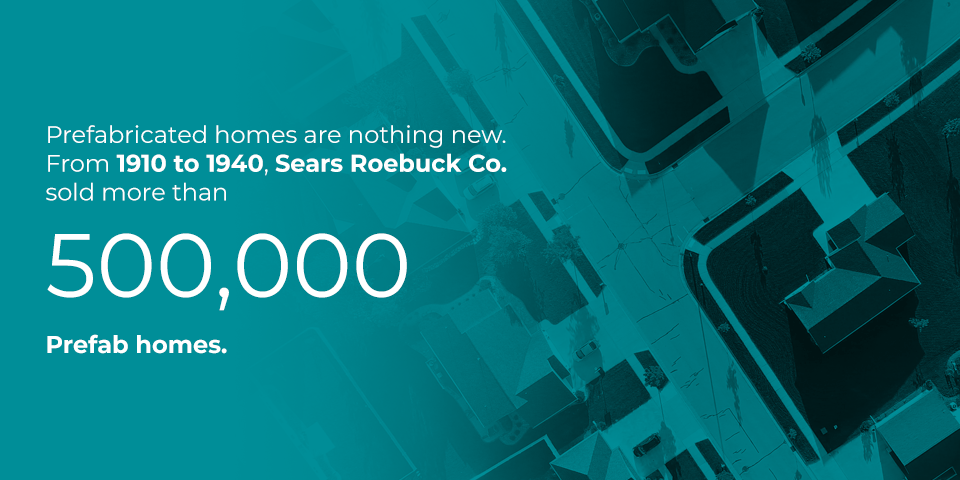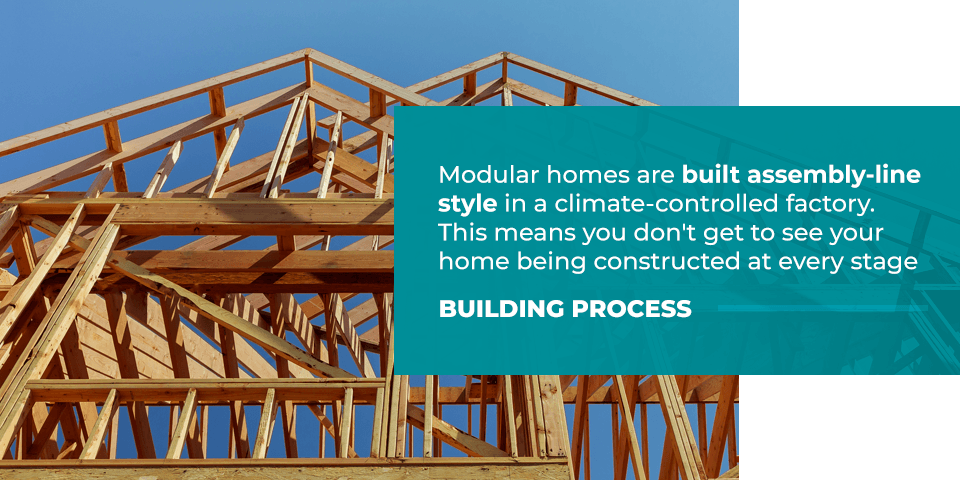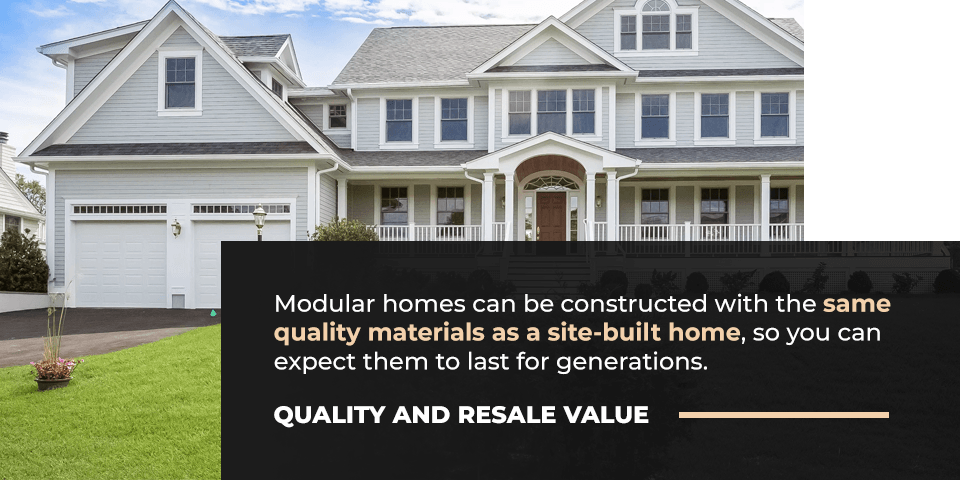
For many people, having their ideal home built is a lifelong dream. You find a piece of land you love, and it’s time to find builders to make your dream a reality. As you get into planning and construction, your excitement may fade as you discover that it ends up costing more and taking longer than you had planned. People in this position may wish they had known sooner about modular homes.
In this post, we’ll discuss the difference between modular homes and stick-built homes, including how they compare in terms of their building process, time frame, design, cost, financing, quality and resale value. Understanding these factors can help you make an informed decision when it comes time to build your dream home.
What Is the Difference Between a Stick Built Home and a Modular Home?

If you’ve looked into having a home built, you may have encountered the term stick-built home. So, what exactly is a stick built house? It refers to the way the house was constructed. The traditional building process for a home happens entirely on-site at the property. The builders lay a foundation and builds the home, board by board — or stick by stick — until it’s complete. This is why traditionally-built homes are often referred to as stick-built homes.
While stick-built homes are still the norm, in recent years, more and more home buyers have discovered that having their house built on site isn’t the only way of obtaining their dream home.
Another term you may have come across is modular homes. So, what is a modular home? These homes are built in large three-dimensional sections, or modules, in a factory. The modules are transported to the property and assembled there. Your contractor will attach the modules to your foundation and to each other so the house is complete. The finished product will meet all the same local building codes that a stick-built home would have to meet. Modular homes are sometimes called “prefab” houses since the sections are prefabricated off-site.
Note, however, that other types of prefabricated homes, like manufactured or mobile homes, are different from modular homes since they are assembled entirely in a factory and then transported in one piece to their destination. So, discussions of manufactured homes vs. stick-built homes won’t give you accurate information about modular homes since they inhabit their own category.
The Evolution of Modular Homes
Prefabricated homes are nothing new. From 1910 to 1940, Sears Roebuck Co. sold more than 500,000 prefab homes. Modular homes became especially popular in the U.S. after World War II when American troops arrived home and needed affordable housing. While modular homes have been around for a long time, it has only been in more recent years that options for modular homes have expanded so a home buyer can have a similar experience going with a modular home as they would a stick-built home.
In the past, factors like your desired style, size, floor plan and materials would help predetermine whether or not you would use a modular home builder or build a stick-built home, but that’s no longer the case. It’s no wonder that, over the past five years, the prefabricated home manufacturing industry has grown by 8.6 percent in the U.S., making it one of the fastest-growing sectors in the construction industry.
Since most people are more familiar with traditional stick-built homes, if you’re interested in purchasing a modular home, you’ll want to compare it to a conventional home. Below, we’ll look at five important homebuilding factors and how the two types compare to each other.
1. Building Process
We’ve already touched on the way stick-built homes and modular homes are built. Let’s look more closely at the difference. Stick built homes are constructed entirely from scratch on site. This has some advantages and some disadvantages. A possible advantage is that you can visit the site whenever you want to see how things are coming along. In many cases, you’ll join your contractor for a frame walk, where you can let them know if you’d like to make any changes before the builders begin adding drywall.
A disadvantage of your house being built from the ground up outside is that it is subject to weather conditions. This means construction can be delayed, as we’ll talk more about in the next section. It also means the framing lumber can become moist and warp, which could cause problems if it’s not thoroughly dried out before the drywall goes on.

Modular homes are built assembly-line style in a climate-controlled factory. This means you don’t get to see your home being constructed at every stage, but it also means the weather is never an issue. When the modules arrive at your property, they typically have everything from wiring, insulation and plumbing to flooring, windows and doors in place. The contractors on site will have very little finishing work they have to do at that point.
2. Time Frame
Time is a significant concern for many people buying a home. Whether you need to be out of your current home by a specific date or want to move into your new home before the arrival of a baby or the start of a new school year, a construction process that drags on can create a great deal of stress.
A timeline can be especially important if you’re rebuilding your home after a disaster because some insurance companies require you to rebuild within a strict time frame. Whatever your time constraints are or your reason for wanting a project done within a certain amount of time, unfortunately, traditional home construction can often end up taking longer than planned.
According to the U.S. Census Bureau, the average time it takes to build a home is six and a half months. Larger or more customized homes take even longer. Some houses may take closer to a year from start to finish. Though your builders will give you an expected timeline, it is not uncommon for weather delays or other problems to extend the timeline. If you’re not in any hurry, this may not be a problem, but the unpredictability of a stick-built home timeline is a disadvantage to most people.
Modular homes are typically finished within three and a half to five months — much sooner than a stick-built home. The building process is more controlled and streamlined with a modular home, so you aren’t likely to run into delays. One major time-saver is that your property can be prepped and the foundation built while the modules of the home are already being constructed in a factory.
3. Design
One of the downsides to a modular house in the past was that they had a “cookie-cutter” appearance and weren’t customizable. With a stick-built home, there has always been endless possibilities for customization. You can look at sample plans from your builder and work to create a design you love. Some people employ an architect to help design their home.
While modular homes may have shared a similar appearance to each other in the past, today, modular homes offer nearly the same possibility for customization as stick-built homes. Looking through a picture gallery of modular homes will reveal that there is no distinguishing look for a modular home. They vary just as widely as site-built homes do. This means you can enjoy the process of designing your modular home and creating something truly unique.

For the home’s exterior, you can choose an architectural style you love. Whether you want a cape cod, ranch, two-story home or any other style, you can make it a reality with a modular home. On the inside, there are limitless options for the floorplan. You can choose a pre-designed floor plan you like, adapt an existing floor plan or work with your builder to create a fully-customized floor plan for your modular home.
It isn’t just the layout of the house that you can customize. You can also put your own personal touch on your home in your choice of materials, bathroom design, kitchen design and more. In the end, a modular home can look exactly like a stick-built home with the same level of sophistication and a design you love. You’ve probably been in many modular buildings before without ever realizing they weren’t built the traditional way. This is because there is no real difference in appearance between the two.
View Our Modular Home Floor Plans
4. Cost and Financing
The cost of a modular home vs. a stick-built is one reason some people consider a modular home to begin with. Cost is always an important consideration for homebuyers who have often saved for many years to afford to build a house. According to a Pew Research Center analysis of recent Census Bureau housing data, renting has become more common today than it has been at any other time in the last 50 years. One survey revealed that 72 percent of renters would like to buy a house, but most said financial reasons held them back.
The good news for budget-conscious home buyers is that modular homes tend to be a bit more affordable than stick-built homes. As with any building project, more premium materials will always drive up the cost, so choosing a modular home is not a guarantee that you’ll stay within your budget. The highest-end modular homes tend to cost the same per square foot as an equivalent stick-built home. On average, though, a modular home typically costs anywhere from 10 to 20 percent less than a new stick-built home. Of course new construction, modular or stick-built is more expensive than the same, pre-existing home.
So, why is the price of a modular home vs. a stick-built home different? One major reason is that modular homes are constructed in controlled conditions, whereas stick-built home building projects can run into unexpected issues like weather events or materials shortages that draw out the process and raise the final cost. Another cost-saver for modular home builders is that they often have in-house inspectors who ensure the quality of your home as it’s being built.
One cost that modular homes carry with them that stick-built homes don’t is transportation. Since modular homes are driven to your location, the number of modules your home is comprised of and the distance from the factory to your property can affect the final price.
Whatever your home costs, you can finance it in any of the same ways you could finance a stick-built home. Some mortgage lenders are willing to finance a modular home at a lower interest rate since there are fewer risks involved.
4. Quality
Modular home quality over time is another big question that many have in mind. Exactly how long do modular homes last? The life span of the home depends on several factors, including the quality of materials, the ability to withstand the elements and maintenance.
Material Quality
Constructing sound modular homes requires investing in premium materials for building. You want to use materials that can last long periods of time yet are still relatively easy to work with. For instance, wood is popular because it is a good insulator against electricity, gains strength from heat when it dries out and is easy to manipulate.

The quality of the materials used in the home will have a direct impact on how long it lasts and how much maintenance it needs. Modular homes can be constructed with the same quality materials as a site-built home, so you can expect them to last for generations. With either type of home, the quality of the materials used is up to your personal choice and budget considerations.
To make sure the material used for your home is of the highest quality and lasts a long time, talk with your builder.
Protection From the Elements
A quality-built modular home can withstand the weather conditions typical of its location. Since the manufacturer builds the home sections indoors, the materials are not exposed to the changing weather. The lack of exposure early on helps establish stronger structural integrity from the start since the material won’t be prone to swelling or shifting, further ensuring the home’s quality in the long run.
Maintenance
Keeping up with maintenance will help protect the quality and prolong the life of your modular home. By taking care of outdoor chores, like making sure there’s no ice buildup on the roof during the winter or clearing the gutters in the spring, you can help make sure your modular home lasts.
If you want a luxury home built from the highest-quality materials, you can do this with a modular home. So, if you’re wondering how long modular homes last, the answer is just as long as stick-built homes, if not longer. As long as the initial structure of the home is carefully considered before construction and continual maintenance is observed, the quality and life span of modular homes will match or exceed those of houses built with other methods.
5. Resale Value
Some people may shy away from modular homes because they fear they will depreciate in value. A home is an investment, and most people want it to be a smart investment, even if they never plan to move out. There is a significant difference in the resale value of manufactured homes vs. stick-built. However, this is not the case for modular homes.
Modular homes used to suffer from a similar stigma as manufactured homes that caused their value to depreciate slightly over time. However, this stigma is no longer a concern. For one, modular homes have become more popular. From 2011 to 2017, around 100,000 modular homes were built in the U.S. Improvements in the process and higher standards in materials have resulted in modular homes matching the quality of stick-built homes.
Many factors can affect your home’s resale value, such as its curb appeal, location, lot size and more. In general, though, there is no difference in a modular home value vs. stick-built. Both stick-built and modular homes are made to last and tend to appreciate value over time. This means, if you ever decide to move, you may be able to sell your home for more than you paid for. Your house will be a home as well as a wise financial investment.
Create Your Dream Home With Design. Build. Modular.
At Design. Build. Modular., we offer a turn-key service for modular homes in Massachusetts and Connecticut. We help you design your perfect modular home, either based on a standard floor plan or completely customized. Whatever your vision is for your home, we can bring it to life. We can help you choose materials that fit within your budget and will complete the look you desire for your home, both inside and out.
We make sure all the logistics are in place from the start so your home can be finished in a timely manner. As timely as we are in building your home, we never compromise on our workmanship. We adhere to all the relevant standards and codes, and all modules are inspected to ensure they meet our standards for quality.
We are so confident in the quality of our homes that we offer a 10-year structural warranty on any modular home we build — an exceptionally long warranty in the construction industry. This means that if any maintenance or repairs are needed during the first decade you’re in your home, we will cover them at no cost to you.
If you’re interested in learning more about modular homes or finding out how we can help make your dream home a reality, contact Design. Build. Modular. today.

